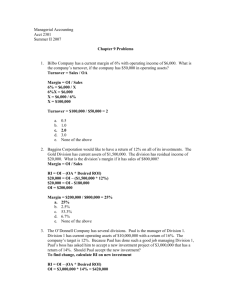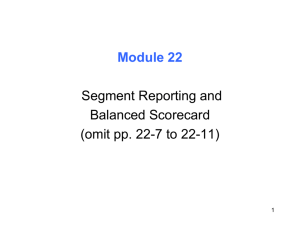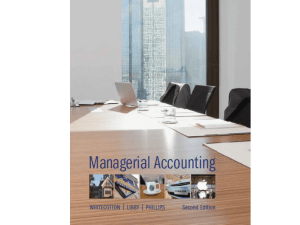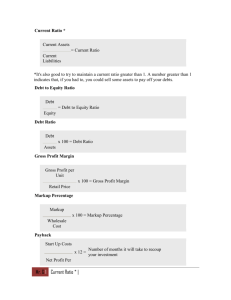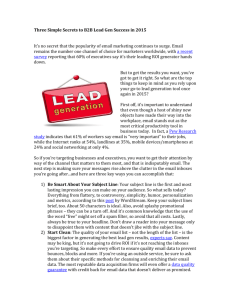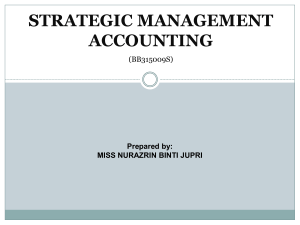- Dr. Gholamreza Zandi Website
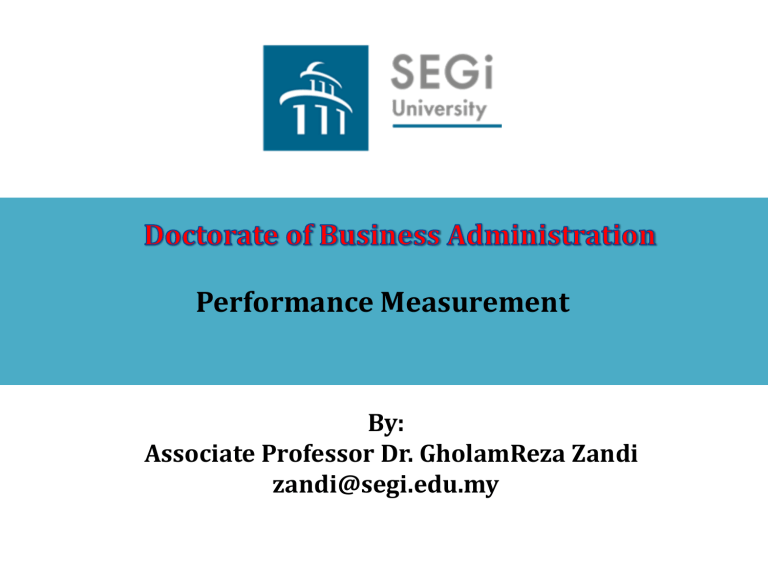
Performance Measurement
By:
Associate Professor Dr. GholamReza Zandi zandi@segi.edu.my
Financial Performance Evaluation
• Organisational Performance
– Balanced Scorecard
• Divisional Performance Measurement
– ROI
– Residual Income
– Economic Value Added
• Individual Performance Measurement
Why Measure Performance?
• Assess achievement of goals
• Provides feedback
• Information that would be useful in future decisions
• Can take corrective actions
Rio Tinto Company
• Rio Tinto Group is a British-
Australian multinational metals and mining corporation with headquarters in London,
United Kingdom , and a management office in Melbourne, Australia . The company was founded in 1873, when a multinational consortium of investors purchased a mine complex on the Rio Tinto river , in Huelva ,
Spain, from the Spanish government.
Rio Tinto Company- Continued
Our targets are designed using the following principles:
• They focus on internal performance, while considering external drivers.
• They must be relevant to the nature of our business.
• They need to be measurable and transparent, consistent with other Rio Tinto objectives.
• They must include a degree of stretch, while being realistically achievable with appropriate management.
Our board endorses our sustainable development targets and receives regular updates on our progress and the key issues affecting performance.
Rio Tinto Example
• Apart from Annual Report we also report under other voluntary commitments, including:
• Global Reporting Initiative
• International Council on Mining and Metals
(ICMM) Sustainable Development Framework
• Millennium Development Goals
• United Nations Global Compact
• Carbon Disclosure Project
• Dow Jones Sustainability Index
• FTSE4Good
• Carbon Disclosure Project Water Disclosure
Source: Rio Tinto (2012) http://www.riotinto.com/sustainabledevelopment2011/performance/index.html
(accessed May 2012)
Rio Tinto Example
Goals and targets Trends Progress to date
Our safety goal is zero injuries and zero fatalities. Two per cent reduction in our all injury frequency rate compared
Progress is measured through our all injury frequency rate (AIFR) with 2010 and a 30 per cent reduction compared with 2008.
per 200,000 hours worked.
30 per cent reduction in the rate of new cases of occupational illness 78 per cent reduction in the rate of new cases of occupational per 10,000 employees between 2008 and 2013. illness compared with 2008.
Ten per cent reduction in the rate of employees per 10,000 employees 4.3 per cent decrease in the rate of employees potentially exposed exposed to an eight hour noise dose of more than 85 decibels to an average eight hour noise dose of more than between 2008 and 2013 (a) . 85 decibels compared with 2008.
Six per cent reduction in total greenhouse gas emissions intensity between 3.8 per cent reduction in our total greenhouse gas
2008 and 2013. We are also targeting a further four per cent reduction emissions intensity compared with 2008.
by 2015, to deliver an overall ten per cent reduction.
.
Six per cent reduction in our freshwater use per tonne of product between 2.7 per cent increase in our freshwater use per
2008 and 2013. tonne of product compared with 2008
Our diversity goal is to employ people based on job requirements who represent the diversity of our surrounding communities.
We are targeting:
Women to represent 20 per cent of our senior management by 2015. Women represented 14 per cent of our senior management in 2011.
Women to represent 40 per cent of our 2015 graduate intake. Women represented 35 per cent of our 2011 graduate intake.
15 per cent of our 2015 graduate intake to be nationals from regions 21 per cent of our 2011 graduate intake were nationals from where we are developing new businesses. regions where we are developing new businesses.
All operations have in place locally appropriate, publicly-reported social 35 per cent of our operations have locally appropriate publicly performance indicators that demonstrate a positive contribution to reported social performance indicators in place after two the economic development of the communities and regions where we work, consistent with the Millennium Development Goals, by 2013.
The Balanced Scorecard
Provides a set of performance measures that reflect entity’s goals and strategies from 4 perspectives :
• Financial – How do we create value for our shareholders?
• Customer – What do new and existing customers value from us?
• Internal Operations – What processes must we excel at to achieve our financial and customer objectives?
• Innovation and Improvement Activities – Can we continue to improve and create value?
Balanced Scorecard
continued
• Measures and drivers are used to monitor progress towards the goals, and they should be communicated throughout the entity
• Key performance indicators (KPIs) are performance measures that are critical for the success of the entity
Balanced Scorecard (example)
Ten Commandments For Success
Lewy and du Mee (1998) state that 70 % of implementations fail and put forward ten commandments for successful implementation:
1.
The scorecard is a basis for implementing strategic goals.
2.
The strategy needs to be in place before the balance scorecard implementation. Ad hoc development will reinforce the wrong behaviour.
3.
Ensure senior management is committed to its success.
4.
Pilot the scorecard to learn valuable lessons.
5.
Gradual introduction of the scorecard to each business unit will ensure a scorecard version to meet the business unit’s needs.
6.
Do not use the scorecard as an extra level of top-down control. This will lead to opposition rather than collaboration.
7.
Do not adopt a standardized scorecard. Should be customised and aligned with corporate strategy.
8.
Do not underestimate the need for training and communication.
9.
Do not overcomplicate the scorecard by striving for perfection. Do not delay the introduction of the scorecard by always searching for ‘better’ indicators.
10. Do not underestimate the additional costs associated with recording administrating and reporting the scorecard.
(Source: Adapted from Smith, M. Performance Measurement and management: A strategic approach to management accounting, SAGE
Publications, London, 2005, p.239-240.)
Criticisms of The Balanced Scorecard
• shareholder focused.
• does not give proper attention to employees and suppliers.
• does not address adequately the selection of specific measures or the role of performance targets.
• causal relationship between some of the measures and its economic impact has never been empirically tested.
E.g. an increase in customer satisfaction or a decrease in cycle time may or may not lead to an economic benefit. Logically the relationship may seem plausible but it has not yet been empirically tested.
Divisional Performance Management
• Organisational structure of an entity helps to
– Direct and control resources to attain mission
– Delineate level, responsibility and authority of a division
• Organisational structure depends on the nature of its business e.g., functional, geographical or enterprise structures, or combinations of these
Prepared by Nicola Beatson
Organisational Structures
Prepared by Nicola Beatson
Organisational Structures
Prepared by Nicola Beatson
Divisional Performance Management
• A manager is normally charged with coordinating the resources of a business unit and the manager is therefore responsible for the unit’s performance
• Different types of responsibilities centres
– Cost centre
– Revenue centre
– Profit centre
– Investment centre
Divisional Performance Evaluation
• A contribution margin format is normally used when reporting on divisional performance
• The main requirement is to distinguish between controllable and non-controllable costs
• Each divisional manager’s performance evaluation should be based on the divisional margin, as they have control only over the revenues and costs above the divisional margin line
Purpose of Segments
• Indicate the level of responsibility and authority of a segment;
• Enable evaluation of a segment’s performance in terms of its classification;
• Provide a guide for allocating costs to enable
– product/service costing
– product/service pricing;
• Enable decisions about possible segment closure, or redeployment of resources and effort;
• Enable considerations about Transfer Price for products/services to other segments; and
• Enable the standardisation of accounting report formats for inter-firm comparisons within a particular industry.
Segment Reports
• The preparation of segment performance reports is to
1.
help evaluate the division’s performance;
2. provide a guide for pricing of products and services; and
3. evaluate the level of investment in each division.
Example – The Fun Hats Company
Evaluate Divisional Performance
•
•
• The Fun Hats Company
• Corporate Department Speciality Total
Stores Stores
• $ $
• Sales 990 000 400 000
$
520 000
$
1 910 000
• Variable Costs 470 000 420 000
• Contribution
Margin 520 000 (20 000)
370 000
150 000
1 260 000
650 000
• Fixed Cost 120 000 50 000 80 000 250 000
• Divisional
Margin 400 000 (70 000) 70 000 400 000
• Common Costs 200 000
• Net Profit $200 000
Allocating Common Costs
Guide for Pricing
•
•
•
• The Fun Hats Company
Corporate Department Speciality Total
Stores Stores
• $ $
• Sales 990 000 400 000
$ $
520 000 1 910 000
• Variable Costs 470 000 420 000 370 000 1 260 000
• Contribution
Margin 520 000 (20 000) 150 000
• Fixed Cost 120 000 50 000 80 000
650 000
250 000
• Divisional
Margin 400 000 (70 000) 70 000 400 000
• Allocated
Common Costs 90 000 30 000 80 000 200 000
• Net Profit 310 000 (100 000 ) (10 000) $200 000
• Floor Space 900m 2 300m 2 800m 2
Investment $2 200 000 $75 000 $225 000
2000m 2
Evaluate The Level of Investment In Each Division
Requires an evaluation of
1. expanding a division, closing a division or redistributing investment funds; and
2. both the short-term and long term consequences of divisional closure.
Investment Centre Performance Evaluation
• Return on Investment
• Residual Income
• Economic Value Added
• Investment Base?????
Traditional Performance Measures - ROI
• ROI is an accounting measure of profit divided by an accounting measure of investment.
ROI =
Profit
Investment
Example
Divisional sales
Divisional profit margin
Divisional investment (assets)
$ 990 000
$ 400 000
$2 200 000
Also called the Accounting Rate of Return (ARR)
Traditional Performance Measures - ROI
• Calculate ROI for The Fun Hats Company
Return on Investment
• Return of Investment (ROI) = profit/investment
•
• ROI = Divisional Margin
Divisional Investment
•
• Corporate Department Stores Speciality
Stores
Division Division Division
•
•
•
• = $400 000 = ($70 000) = $70 000
$2 200 000 $75 000 $225 000
•
• = 18.18% = (93.3%) = 31.1%
Return On Investment
continued
• Further analysis can be conducted using Du Pont ROI
Du Pont ROI = Profit margin x Investment turnover
Profit
Investment
= Profit
Sales x Sales
Investment
• Example
Du Pont ROI = Profit margin x Investment turnover
$400 000
$2 200 000
18.2%
= $400 000
$990 000
= 40.4% x x
$990 000
$2 200 000
0.45 times
Profit
Investment
Du Point ROI = Return On Sales x Investment Turnover
= Profit
Sales x Sales
Investment
Using this formula for each of our divisions would give the following:
ROI = Return on sales x Investment Turnover
Corporate
400,000 = 400,000 x 990,000
2,200,000 990,000 2,200,000
18.18% = 40.4% x 0.45 times
Department ($70 000)
$75 000 =
-93.3% =
($70 000)
$400 000 x
-17.5% x
$400 000
$75 000
5.3 times
Specialty $70 000
Store
$70 000
$225 000 =
$520 000
$520 000 x $225 000
31.1% = 13.46% x 2.31 times
Return On Investment
continued
Advantages
• Easy to use and understand
• Links profit with investment base, thus increasing awareness of asset management and discouraging overinvestment
• Relationship between assets balance sheet and profit in income statement can be easily linked
Disadvantages
• % measure, not measure of absolute values
• Does not consider divisions that differ in size or type
• Divisional managers can manipulate ROI by decreasing investment base relative to segment profit
• ROI could result in suboptimal decision making
ROI Suboptimal Decision Making Example
Specialty Store Division has an opportunity to expand into another geographical market with an investment requirement of $50 000 and an expected segment return of $12
500. The expected ROI of this expansion would be 25%.
Recall existing ROI: 31.1%
Would the Specialty Store Division manager decide to expand if performance measurement was based on ROI?
Existing + Expansion New ROI
$70 000 $12 500 $82 500
$225 000 $50 000 $275 000
= 31.1% = 25% = 30%
• Congruency
Residual Income
• The formula for residual income is
Residual income (RI) = Profit before tax
– (Required rate of return x Investment)
• Example
– Assume required rate of return in 15%
RI = $400 000 – (0.15 x $2 200 000)
= $70 000
Residual Income
Residual Income (RI) =
Profit before tax – required rate of return x investment
Corporate
Division = $ 400,000- (15% x 2,200,000) = $ 70,000
Department
Stores Division = -$70 000 - (.15 x $75 000) = -$81250
Specialty
Stores Division = $70 000 - (.15 x $225 000) = $36 250
Expansion Opportunity Revisited
Specialty Store Division Manager new RI with expansion
Residual Income (RI)
= Profit before tax – required rate of return x investment
= ($70 000 + $12 500) – [15% x ($225 000 + $50 000)]
= $41 250
Increase RI therefore would take on expansion.
Residual Income
Advantages
• Use of Residual Income encourages managers to concentrate on maximising an absolute amount ($ of RI) rather than a % such as ROI.
• The objective of maximising RI means that as long as the division earns a return in excess of RRR they should keep investing.
• Minimises the suboptimal decision making that could result from the use of
ROI. A manager would take on a new investment opportunity if the dollar return is greater than the charge for the extra capital invested.
• The charge for capital can vary across divisions based on the risk of the venture being pursued in each division.
Disadvantages
• RI can still encourage short term decision making.
• The cost of capital may not be easy to determine.
•
Corporate Department Stores Specialty Stores Total
Sales 990 000
Variable Costs 470 000
000
400 000 520 000 1 910 000
420 000 370 000 1 260
Contribution Margin 520 000 (20 000) 150 000 650 000
Fixed Cost 120 000 (50 000) 80 000 250 000
Divisional Margin 400 000 (70 000) 70 000 400 000
Common Costs 90 000 30 000 80 000 200 000
Net Profit 310 000 (100 000) (10 000) 200 000
Current Assets 1 000 000 75 000 50 000
Non-current Assets 1 400 000 75 000 200 000
Total Assets 2 400 000 150 000 250 000
Accumulated
Depreciation 200 000 75 000 25 000
Asset Book Value 2 200 000 75 000 225 000 2 500 000
Current Liabilities 110 000 36 750 12 600 159 350
Floor Space 900m 2 300m 2 800m 2 2000m 2
Investment $2 200 000 $75 000 $225 000
Economic Value Added
• Based on economic increase in value after a suitable charge for capital is subtracted
EVA = Profit after tax (PAT) – (Cost of capital x Capital)
• Example
Less Current liabilities
= Long-term assets x WACC
PAT
EVA
$2 200 000
$ 110 000
$2 090 000
15.4%
$400 000 x (1 – 0.30)
$280 000 – $321 860
= $ 321 860
= $ 280 000
= – $ 41 860
Economic Value Added
EVA ® = Net Operating Profit after tax (NOPAT) – (cost of capital x capital)
NOPAT
Corporate Department Store Specialty
400,000 (1-0.30) -$70 000 x (1 – 0.30) $70 000 x (1 – 0.30)
= $ 280,000 = -$49 000 = $49 000
Assets $ 2,200,000 $75 000 $225 000
- Current Liabilities $ 110,000 $36 750 $ 12 600
= Long Term Assets $2,090,000 $38 250 $212 400
X WACC 15.4% 15.4% 15.4%
= 321,860 $ 5 890 $ 32 710
EVA ® $ 280000 – 321860 $49 000 - $5 890$ 49 000 - $32 710
-41,860 -$54 890 $16 290
EVA Adjustments
Stern Stewart has developed over 100 adjustments depending on the nature of the company.
Some of the adjustments include:
• Adding back the research and development costs. The logic being that these costs should be capitalised and written off in the financial years that they bring benefits not when they are incurred. The amount spent on research and development should be seen as an investment not an expense.
• Adding back the marketing costs. For the same reason as stated above the costs spent on marketing should be capitalised and written off over the years that the benefit accrues.
• Goodwill should not be amortised as this represents the intangible assets of an organisation and not an expense as treated under conservative accounting standards.
Economic Value Added ®
Advantages
• The minimisation of suboptimal decision making. That is, by subtracting the charge for capital it focuses managers attention on the economic value added to the organisation. It is argued that this helps managers make decisions similar to those made if they were the owners.
• The charge can vary to take into account various risk levels.
• Adjustments can be made to the components within the equation to suit the specific circumstances of each division.
Disadvantages
• The complexity of the modifications to the formula.
• The modifications could be seen as being manipulated.
• It is still a short term economic performance indicator based on financial accounting data.
® Registered Trademark of the Stern Stewart Company
ROI, RI and EVA ® Compared
•
ROI RI EVA ®
Corporate 18.2% $70 000 -$41 860
Department Stores -93.3% -$81 250 -$54 890
Specialty Stores 31.1% $36 250 $16 290
Investment Base- How Should It Be Valued?
To calculate the ROI and RI the investment base was needed. Could use:
• the gross book value (original cost),
• the net book value (written down value), or
• the market value (current cost).
• Note: EVA® uses long term assets (total assets – current liabilities) as its investment base
Investment Base for Specialty Store Division
Value ROI RI
Written Down value or Net Book Value $225 000 31.1% $36 250
Original cost or
Gross Book Value $260 000 26.9% $31 000
Market Value $300 000 23.3% $25 000
Environmental And Social Performance
• In order to assess environmental and social dimensions there is a need to develop, track and monitor key performance indicators.
1.
Operational Performance Indictor (OPI) that provides information about the environmental performance of an organisation’s operations.
2.
Management Performance Indicator (MPI) that provides information about the management’s efforts to influence an organisation’s environmental performance.
3.
Environmental Condition Indicator (ECI) that provides information about the local, regional, national or global condition of the environment.
Environmental And Social Performance continued
• Just like financial information the UNDSD has put forward some basic principles to be applied. They are
– Relevance;
– Understandability;
– Target orientation;
– Consistency;
– Comparability;
– Balanced view; and
– Continuity.
Eco-Efficiency
• The organisation of economic and co-operative development (OECD) states that eco-efficiency:
“expresses the efficiency with which ecological resources are used to meet human needs”
• The purpose is to integrate ecological impact with economic information.
• The result will show the environmental impact added per chosen unit of economic performance.
Greenhouse Gas Accounting
• Many companies and countries report on their performance in relation to their CO
2 emissions
• The objective of placing a price on carbon is to promote lower carbon ways of living, either pay the price or invest in lower carbon emitting processes.
Carbon pricing is a topical economic concern –
The G20 in Brisbane in 2014!
Abbott & Obama on climate change
Obama at G20
Individual Performance Measurement
• Companies are artificial entities and do not perform any physical function
– Apart from bringing owners, workers and resources together under a legal structure
• People working within companies perform multiple tasks, individually and in teams, to help accomplish the organisation’s goals
• Therefore, performance measurement at the individual level should highlight to the employees what tasks are important
Individual Performance Measurement continued
• The reward system is also part of performance measurement system
– Some companies encourage teamwork by including rewards based on team, department or company-wide performance
– Advantage is encouraging employees to work together and hopefully achieve synergies that individuals could not achieve working alone
– Disadvantage is the difficulty of managing individuals who shrink their responsibilities
Non-Financial Performance Evaluation
• Use of financial performance measures alone is insufficient to gauge organisational success
• Non-financial measures should be
– linked to organisation’s goals
– well defined
– easily understood
– based on reliable data
Non-Financial Performance Evaluation
• Advantages
– More user friendly and relevant to nonmanagement employees
– More likely to lead to long term performance gains
– Diminish likelihood of short term management decision making
– Identify problems in a more timely fashion
– Can be easily structured to suit an organisation’s goals
– Can be benchmarked easily
• Disadvantages
– Subjective in nature
– Number of measures must be limited to increase understanding and reduce cost
– Inappropriate measures can be chosen
– No proven cause and effect link between non-financial measures and economic success
– Various measures give conflicting results
Non-Financial Performance Evaluation
Non-Financial Performance Evaluation continued
Non-Financial Performance evaluation continued
Prepared by Nicola Beatson
